NOTTINGHAM CASTLE LEGENDS
Lionheart, Mortimer’s Hole and Robin Hood
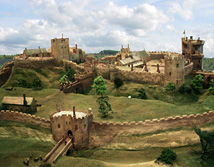 Nottingham Castle is certainly not what it once was. In fact, there is no castle at Nottingham Castle. What was once regarded as the best fortified castle in the England of the middle-ages, due to its commanding defensible position on a high promontory just south of the village of Nottingham. With cliffs of 130 feet on the south and west facing sides, the “Castle Rock” of Nottingham was considered impregnable, but this reputation was turned on its head at the Parliament of October 19th, 1330. The young King Edward III was in residence with his new wife Queen Philippa and their infant child. The young king’s mother Queen Isabella and her lover Roger Mortimer, Lord of Wigmore, had overthrown her husband King Edward II and maneuvered her son onto the throne, and by this time had the old king murdered while being held at Berkeley Castle in Gloucestershire (see Berkeley Castle Edward II Cell), holding power through a regency council. The young king had reached his 18th birthday and was asking parliament to remove the regency council, which would have ended the control of Mortimer and Isabella.
Nottingham Castle is certainly not what it once was. In fact, there is no castle at Nottingham Castle. What was once regarded as the best fortified castle in the England of the middle-ages, due to its commanding defensible position on a high promontory just south of the village of Nottingham. With cliffs of 130 feet on the south and west facing sides, the “Castle Rock” of Nottingham was considered impregnable, but this reputation was turned on its head at the Parliament of October 19th, 1330. The young King Edward III was in residence with his new wife Queen Philippa and their infant child. The young king’s mother Queen Isabella and her lover Roger Mortimer, Lord of Wigmore, had overthrown her husband King Edward II and maneuvered her son onto the throne, and by this time had the old king murdered while being held at Berkeley Castle in Gloucestershire (see Berkeley Castle Edward II Cell), holding power through a regency council. The young king had reached his 18th birthday and was asking parliament to remove the regency council, which would have ended the control of Mortimer and Isabella.
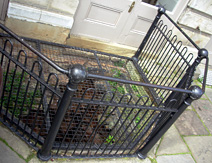 Mortimer had set about a plan to murder the king and place his new infant son on the throne, to effectively seize the kingdom by force of arms and make himself Lord Protector. Edward got wind of this plot and had learned that a secret cave led from the castle to the base of the hill as an escape sally port from earlier days. A small force of knights loyal to Edward and the Earl of Lancaster were led by William Montagu (see National Car Museum Beaulieu) up through the tunnel to capture Mortimer and the Queen Mother by surprise and seized power. If they had arrived too late, England would have a very different history.
Mortimer had set about a plan to murder the king and place his new infant son on the throne, to effectively seize the kingdom by force of arms and make himself Lord Protector. Edward got wind of this plot and had learned that a secret cave led from the castle to the base of the hill as an escape sally port from earlier days. A small force of knights loyal to Edward and the Earl of Lancaster were led by William Montagu (see National Car Museum Beaulieu) up through the tunnel to capture Mortimer and the Queen Mother by surprise and seized power. If they had arrived too late, England would have a very different history.
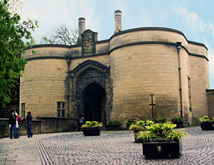 Nottingham Castle played its other more familiar part in the battle of kings and usurpers in the struggle for power between King Richard I, known as Lionheart and his brother Prince John, and the legend of Robin Hood. Whether Robin Hood actually existed is still a matter of debate (see Robin Hood and Sherwood Forest), and the castle has played a role in drama that is perhaps not its real history. It has been portrayed in movies as the site of a battle between Richard and his brother John in 1194, on Richard’s return from the Third Crusade and his imprisonment by Leopold V at Castle Durnstein along the Danube in Austria (see Castle Durnstein Richard Lionheart Ransom), but after his release and a few excommunications by the Pope, Richard was too focused on regaining his lands in France to worry what John was up to, as long as he was collecting taxes for the crown. He only returned to England for a few weeks in 1194 and had no time or inclination for fighting any battles there. He named John as his official heir and for sailed France, never returning to England.
Nottingham Castle played its other more familiar part in the battle of kings and usurpers in the struggle for power between King Richard I, known as Lionheart and his brother Prince John, and the legend of Robin Hood. Whether Robin Hood actually existed is still a matter of debate (see Robin Hood and Sherwood Forest), and the castle has played a role in drama that is perhaps not its real history. It has been portrayed in movies as the site of a battle between Richard and his brother John in 1194, on Richard’s return from the Third Crusade and his imprisonment by Leopold V at Castle Durnstein along the Danube in Austria (see Castle Durnstein Richard Lionheart Ransom), but after his release and a few excommunications by the Pope, Richard was too focused on regaining his lands in France to worry what John was up to, as long as he was collecting taxes for the crown. He only returned to England for a few weeks in 1194 and had no time or inclination for fighting any battles there. He named John as his official heir and for sailed France, never returning to England.
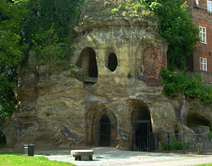 Edward III made improvements to the castle, adding a tower on the west side and expanding a prison under the main tower. The last Plantagenet king to see Nottingham was Richard II at a council in the north in 1397. The castle was granted to Henry IV’s Queen Joan as a residence until 1437 and during the next years it became a stronghold in the War of the Roses, when Edward IV claimed the crown at Nottingham and built yet another tower and expanded the royal apartments. Henry VIII added new tapestries to the residence and increased the garrison of the castle, but it was already showing significant signs of decay and ruin.
Edward III made improvements to the castle, adding a tower on the west side and expanding a prison under the main tower. The last Plantagenet king to see Nottingham was Richard II at a council in the north in 1397. The castle was granted to Henry IV’s Queen Joan as a residence until 1437 and during the next years it became a stronghold in the War of the Roses, when Edward IV claimed the crown at Nottingham and built yet another tower and expanded the royal apartments. Henry VIII added new tapestries to the residence and increased the garrison of the castle, but it was already showing significant signs of decay and ruin.
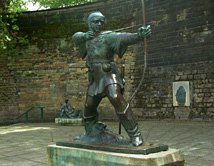 The final blow to the castle came in the Civil War of the Cromwellian Parliament. Charles I formed his armies at Nottingham in August of 1642, but as soon as he left the castle it was taken by the parliamentarians, who held it against repeated Royalist attacks. The great castle at Nottingham saw its end with the execution of the monarch. Following the Civil War of the medieval fortress castle of Nottingham was nearly completely destroyed, razed to the foundations. What remains, is the medieval gate house which faces the city of Nottingham, and the tunnel known as Mortimer’s Hole (see Mortimer's Hole and Traitor's Gate), now much wider and more well-trod than in its time in history. The cave through the sandstone now has stair steps and hand rails for its service as a tourist destination.
The final blow to the castle came in the Civil War of the Cromwellian Parliament. Charles I formed his armies at Nottingham in August of 1642, but as soon as he left the castle it was taken by the parliamentarians, who held it against repeated Royalist attacks. The great castle at Nottingham saw its end with the execution of the monarch. Following the Civil War of the medieval fortress castle of Nottingham was nearly completely destroyed, razed to the foundations. What remains, is the medieval gate house which faces the city of Nottingham, and the tunnel known as Mortimer’s Hole (see Mortimer's Hole and Traitor's Gate), now much wider and more well-trod than in its time in history. The cave through the sandstone now has stair steps and hand rails for its service as a tourist destination.
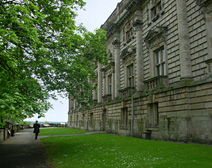 Standing at the site of the castle today is the 17th Century “Ducal Mansion’, built by the Henry Cavendish, the 2nd Duke of Newcastle, in 1674, and designed by Samuel Marsh, who also provided the work for the Duke’s reconstruction of Bolsover Castle. The original Newcastle line died out and the title was granted to a new family peerage, and by the early 1800s Nottingham had grown into a grimy industrial center in the north. When the 4th Duke of Newcastle, Henry Pelham-Clinton opposed the Reform Act of 1832, rioters from the slums of workers’ housing attacked the mansion and burned it. The land was granted to the city of Nottingham and the house was restored in 1878, opened as the Nottingham Museum, the first municipal art gallery in England outside of London. The grand steps approach to the mansion were removed to make room for the Robin Hood Rifles Regimental parade ground, where a statue of the legendary outlaw can be found, but rather ruining the presentation of the manor. Art on display inside the museum includes fine artists from the UK and Europe, as well as local artists.
Standing at the site of the castle today is the 17th Century “Ducal Mansion’, built by the Henry Cavendish, the 2nd Duke of Newcastle, in 1674, and designed by Samuel Marsh, who also provided the work for the Duke’s reconstruction of Bolsover Castle. The original Newcastle line died out and the title was granted to a new family peerage, and by the early 1800s Nottingham had grown into a grimy industrial center in the north. When the 4th Duke of Newcastle, Henry Pelham-Clinton opposed the Reform Act of 1832, rioters from the slums of workers’ housing attacked the mansion and burned it. The land was granted to the city of Nottingham and the house was restored in 1878, opened as the Nottingham Museum, the first municipal art gallery in England outside of London. The grand steps approach to the mansion were removed to make room for the Robin Hood Rifles Regimental parade ground, where a statue of the legendary outlaw can be found, but rather ruining the presentation of the manor. Art on display inside the museum includes fine artists from the UK and Europe, as well as local artists.
Visiting Nottingham Castle
Opening times of the castle are 10am to 5pm seven days a week from Mid-February to the end of October and Wednesday to Sunday 10am to 4pm from November to February. Admission price is £5.50 adults, £4 Students and Seniors, Children under 5 are free. This includes the museum and the grounds. Entrance to the Mortimer’s Hole caves is by guided tour, offered four times a day, with a separate charge of £4 per person. There are lots of steps, but going down, rather than up, after all you’re not there to overthrow the kingdom. © Bargain Travel Europe
Find best hotel and travel deals in Nottingham on TripAdvisor
Web Info
Nottingham Castle
These articles are copyrighted and the sole property of Bargain Travel Europe and WLPV, LLC. and may not be copied or reprinted without permission.
SEE ALSO:
BYRON'S NEWSTEAD ABBEY - NOTTINGHAM
DONINGTON PARK GRAND PRIX RACE CAR MUSEUM
HOTEL RICHARD LOWENHERZ DURSTEIN


